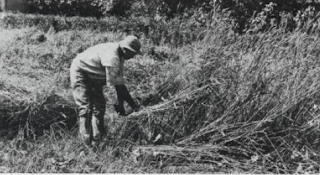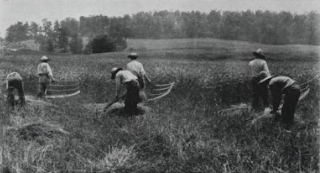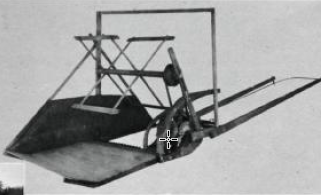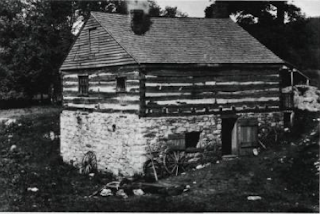 |
IH History, p 3
A sickle allowed a farmer to harvest a half acre a day. |
By 1830, the cast-iron moldboard plow had already replaced manpower with horsepower for tilling the fields. But harvesting was still using manpower. Wheat can't be harvested until it is ripe. But a ripe wheat plant has a dead stem, called straw, that nature designed to become weak and collapse so that the seeds in the head would fall to the ground. This provides about a 10-day harvest window between when the wheat is ready to harvest and when the winds and rains have knocked down the plants so badly that they can't be harvested. Since a man could cut only about a half acre a day, 19 out of 20 men had to work on the farm to feed those few who could work in a town. Also, towns had to be close to the farmers who supported them because in 1830 farm production was transported to market with horse and wagon.
As long as the wheat was still standing, a scythe allowed a man to cut two acres a day. During the 1700s, the cradle was invented by adding wooden fingers to the blade of the scythe. This allowed the cut grain to be thrown into swaths. This made it easier for others to gather the wheat and bind it into sheaves.
The reaper had a reel and a reciprocating knife driven by the wheels. The platform accumulated the cut wheat so that it could be racked off into a swath and bound into sheaves. This in creased the farmer's productivity so much that families were displaced from farming. Fortunately, the industrial revolution was in progress and families could find jobs in factories or on the railroad as more reapers were sold. And cities began to form in the late 1800s.
Cyrus Hall McCormick built the first successful mechanical reaper in this one-room blacksmith near
Steele's Tavern, Virginia.
<make first plants another post that is referenced>

Christy George Kruckeberg posted
D.M. OSBOURNE REAPER for sale. Museum quality made in Auburn New York. $7500 or good offer
Actually, a daisy.
 |
| John Porter posted, fourth photo |
Some pictures of a daisy that is for sale.
A video of mowing hay with two horses.
A video of the early history of the reaper. Even the first primative looking reapers could cut more corn than 8-10 scythe workers.
McCormick reaper history, 1847 is when he built his factory in Chicago






No comments:
Post a Comment